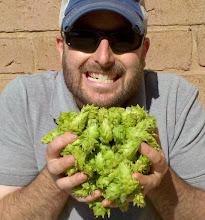The last
Vienna Lager I made was great! I also brewed up an interesting
Vienna Agave Lager last year that was well received. I'm hoping that this beer will be an instant hit with our New Year's party crowd and I'd like to bottle out some for evaluation.
On another note, I'm still dialing in the
recirculation immersion wort chiller. The biggest problem was with the
Quick Disconnects (QDs) which were clogging the pump system. In both sides of the QD components, a cross-hair structure would collect hop matter and slow the March pump to a trickle.
 |
| QD's for the March Pump. |
Shown is the tubing end of the QD but there's also two other components that are attached to the pump. They also have the same structure imposing on the flow. A total of four blocking points have been reeking havoc on the recirculation flow during wort chilling. Using a Dremel tool, I drilled and sanded out all four flow restrictions.
 |
| Left QD shows the original "hop blocker". Right, rough drilling. |
After cleaning them up with a sanding bit, I could easily tell the flow rate will have significantly less interruption. The only restriction points are now the 1/2" barbs. After testing this out today, no small hop matter and trub was locked up at any point along the recirculation route. I'm chillindamos again.
 |
| Using a dremel, both QD's are opened up for business! |
The only other frustration, and restriction point, on the recirculation pump system has been with the kettle spigot. I took the spigot over to Home Depot and Lowe's during the summer to try and find a replacement with no avail. It seems the threading was not standard. Larry over at
Home Brew Mart and
Ballast Point Brewing identified the pot with the spigot to be an Italian design with its own spec. He suggested some options including simply taking out the spigot tip (I had managed to squeeze in a narrow barb that hasn't been working very well - the tightest restriction point at the moment) and finding some 1/2" ID tubing to stretch right over it. We also talked about drilling a new hole and replacing the spigot.
 |
| With heat left over from the boil, the tubing molded easily to the Italian spigot. |
Since the contours of the kettle spigot are thicker on the end, the tubing seemed to create a good seal without the use of any clamps.
 |
| Tubing leaving the kettle to the March Pump. |
I thought this tubing was high temp and originally thought I might have to leave it on the kettle at all times. I had to remove it when it started showing signs of melting, yikes! At least I was able to cut off that section and found that it was really easy to remove and reinstall the tubing with a tight seal whenever I wanted.
 |
| Immersion Chiller combined with Wort Recirculation. |
Further modifications have led to even more chillindamos! The circulation happening in the pot was significant compared to before the dremel work and tubing makeover. I went through even less water and reduced more time to chill the wort. Now back to beer.
Vienna Lager
BJCP Category 3A. Vienna Lager
5 Gallons, All Grain, Step Infusion Mash, 90 Minute Boil
6 lbs. Vienna
3 lbs. Munich
3 lbs. Belgian Pilsner
4 oz. Caramunich
4 oz. Caravienne
Protein Rest at 122°F for 7 minutes
(0.9 qts/lb. raised to 135°F)
Saccharification Rest at 148°F for 60 minutes
(0.5 qts/lb. raised to 212°F)
Fly-sparged at 170°F
1.5 oz. Tettnanger 60 min.
1 Whirlfloc tab 20 min.
1 oz. Spalt 10 min.
White Labs WLP830 German Lager Yeast (100ml of fresh slurry thanks to Kara!)
Currently in ferment at 52°F
OG: 1.053 @ 73°F
FG: 1.013 @ 40°F
ABV: 5.6%












No comments:
Post a Comment
Make a comment already. While waiting for your comment to be moderated, have a homebrew!